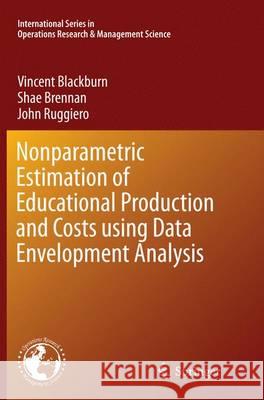Nonparametric Estimation of Educational Production and Costs Using Data Envelopment Analysis » książka
Nonparametric Estimation of Educational Production and Costs Using Data Envelopment Analysis
ISBN-13: 9781489978585 / Angielski / Miękka / 2016 / 152 str.
Nonparametric Estimation of Educational Production and Costs Using Data Envelopment Analysis
ISBN-13: 9781489978585 / Angielski / Miękka / 2016 / 152 str.
(netto: 191,66 VAT: 5%)
Najniższa cena z 30 dni: 192,74
ok. 22 dni roboczych
Dostawa w 2026 r.
Darmowa dostawa!
This book provides a complete analysis of educational production and costs using the nonparametric technique known as Data Envelopment Analysis (DEA). The book focuses on estimation of technical, allocative and scale efficiency in the public sector characterized by the influence of exogenous socio-economic variables. State of the art DEA models will be presented and fully discussed. Specific education topics important to policy makers including adequacy, efficiency, productivity, environmental costs and equity will be analyzed. To illustrate how these techniques can be applied to school systems worldwide, the authors use data on Australian elementary and high schools to develop nonparametric measures that will help inform current policy debate in Australia. They also discuss the applicability of these analysis techniques and methodologies to certain related scenarios.The purpose of the book is to provide a comprehensive analysis of educational production using numerous DEA models that have been developed. Chapters 3 - 7 and 9 were developed in the literature as extensions to the basic DEA models. Each chapter explains why new advances in DEA were needed in order to carry out accurate analysis of educational production, and then presents the use of these new techniques within the context of educational performance, productivity, and cost. These extensions were based on public sector production in general, and educational production in particular. The models showed that traditional DEA improperly controlled for exogenous factors of production like the socioeconomic conditions prevalent in the education setting. In addition, models of educational funding typically use ad hoc and simple approaches that often assume that schools operate efficiently. This book uses economic and mathematical models to further our understanding of educational production while providing various measures of economic performance. The authors use current data on Australian schools to highlight important policy questions related to efficiency, economies of size and how scarce resources can best be spent to improve performance.This research focus comes at an important watershed moment in the Australian Federal Governments' current involvement in designing new nationally consistent funding models for both government and non-government schooling sectors with effect from 2014. A new National School Resourcing Standard is proposed to be implemented signaling a move to resource adequacy, school efficiency and value for money dimensions. These proposed innovative schooling resourcing developments will enable the Australian school efficiency and productivity studies to serve as the basis to evaluate the funding changes, in order to determine whether there have been significantly different student performance outcomes in the transition from a 'centralized' to a new 'decentralized' set of school funding arrangements.











